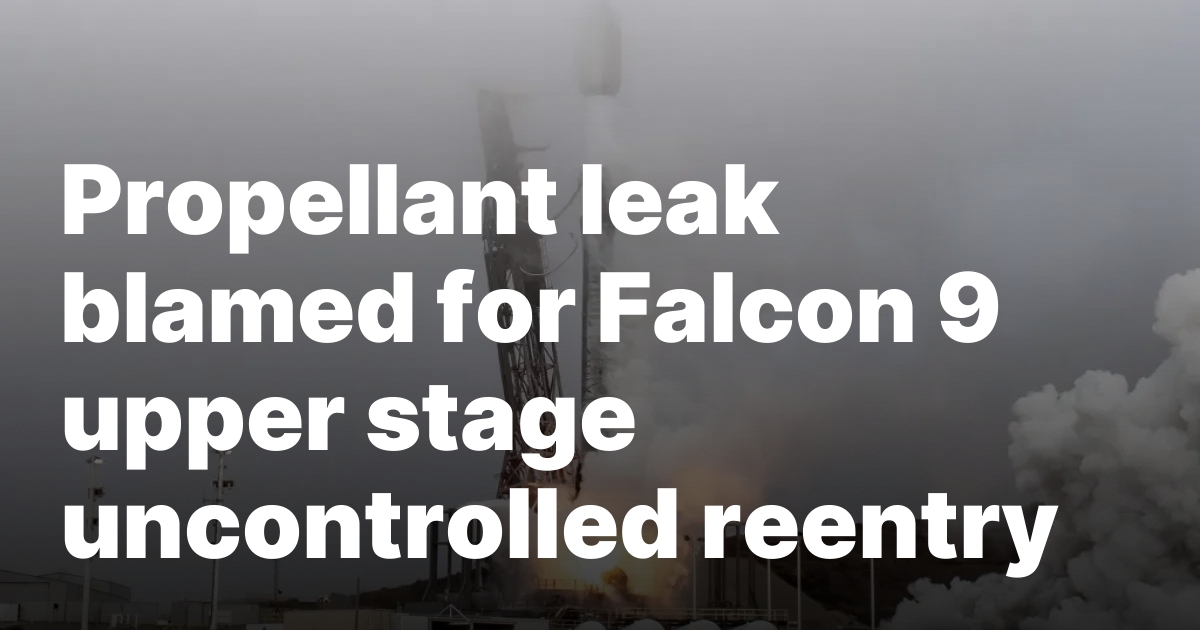SpaceX Faces Falcon 9 Upper Stage Anomaly Due to Propellant Leak
In the world of space exploration, even the most advanced technology can face unexpected challenges. Recently, SpaceX, a leading player in the space industry, experienced such a challenge with one of its Falcon 9 rockets. This event has drawn attention from both the aerospace community and the public due to its implications for future launches and safety protocols.
On February 1st, SpaceX launched a Falcon 9 rocket from Vandenberg Space Force Base in California. The rocket’s primary mission was to deploy 22 Starlink satellites into low Earth orbit as part of the Group 11-4 mission. This mission was crucial for expanding SpaceX’s Starlink internet service, which aims to provide high-speed internet access across the globe, particularly in underserved areas.
After the successful deployment of the satellites, the upper stage of the Falcon 9 rocket was supposed to perform a controlled reentry burn. This maneuver is a standard procedure for deorbiting the upper stage safely over the ocean, minimizing the risk of debris falling on populated areas. However, things did not go as planned.
According to SpaceX, the upper stage encountered a liquid oxygen leak during the coast phase of its mission. This leak resulted in higher than expected vehicle body rates, which means the rocket’s movement became more erratic than usual. As a safety measure, SpaceX decided to passivate the upper stage. Passivation involves venting remaining propellants and discharging batteries to minimize the risk of explosions or uncontrolled breakups.
Unfortunately, despite these efforts, the upper stage did not perform the intended deorbit burn and remained in orbit. Over time, atmospheric drag caused the stage’s orbit to decay, and on February 19th, it reentered Earth’s atmosphere over Europe. Debris from the stage, including composite overwrapped pressure vessels, landed in Poland, near the city of Poznań. The falling debris caused minor damage, such as a broken light fixture. One local farmer reported a crater in his field caused by the debris and expressed intentions to seek compensation from SpaceX.
This incident marks the third time in recent months that a Falcon 9 upper stage has faced issues. In July 2024, a similar liquid oxygen leak prevented an upper stage from completing a circularization burn during a Starlink mission. As a result, the satellites deployed into lower than intended orbits and soon reentered the atmosphere due to high atmospheric drag.
In another incident during the Crew-9 mission to the International Space Station, the upper stage performed an "off-nominal deorbit burn," leading to an unintended reentry outside the designated zone in the South Pacific Ocean. These repeated anomalies have raised concerns within the aerospace community.
The Federal Aviation Administration (FAA), responsible for overseeing commercial spaceflight safety, closely monitored these incidents. Following thorough investigations, they granted SpaceX the approval to resume launches. However, these events underscore the importance of rigorous safety protocols and continuous assessment of rocket components.
The Aerospace Safety Advisory Panel, an independent safety committee of NASA, has also expressed concern. Kent Rominger, a former astronaut and panel member, emphasized the necessity for meticulous attention to detail, especially as hardware ages and the frequency of launches increases. His remarks highlight the challenges faced by companies like SpaceX in maintaining safety while pushing the boundaries of space exploration.
Despite these setbacks, SpaceX remains committed to addressing the underlying causes of these incidents. The company has stated that it is actively assessing the root cause of the recent liquid oxygen leak and has already implemented mitigations for future flights. These measures are crucial to prevent similar occurrences and ensure the safety of both missions and the public.
For readers unfamiliar with the technical jargon, "liquid oxygen" is a cryogenic liquid used as an oxidizer in rocket engines. It combines with fuel to produce the necessary thrust for rocket propulsion. A leak in this system can lead to engine performance issues, as seen in these incidents.
Looking beyond the immediate technical challenges, it’s essential to recognize the broader context of SpaceX’s work. The company has revolutionized space travel with its reusable rocket technology and ambitious projects like the Starship, which aims to enable human colonization of Mars. The Starlink constellation, despite its challenges, represents a significant step towards global internet coverage.
These recent anomalies, while concerning, are part of the iterative process of technological advancement. Each incident offers valuable lessons that contribute to refining systems and improving future missions. SpaceX’s willingness to address these issues transparently and proactively is a testament to its commitment to safety and innovation.
As the space industry continues to evolve, incidents like these serve as reminders of the complexities involved in launching and managing spacecraft. They underscore the importance of collaboration between private companies, government agencies, and international partners to ensure space exploration remains safe and sustainable.
In conclusion, while the recent Falcon 9 upper stage anomaly posed challenges, it also provided opportunities for learning and improvement. SpaceX’s response and ongoing efforts to mitigate future risks demonstrate the company’s dedication to maintaining its leadership in the space industry. As technology advances and missions become more ambitious, the lessons learned from these events will undoubtedly play a crucial role in shaping the future of space exploration.
For more detailed information on this incident and SpaceX’s missions, interested readers can visit SpaceX’s official website.
For more Information, Refer to this article.


































![Good Lock Features: Discover the Top Favorites [Exploring Good Lock ②] Unveiling the Most Popular Good Lock Features](https://www.hawkdive.com/media/samsung-mobile-good-lock-home-up-3-most-popular-features_thumb728-218x150.gif)